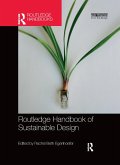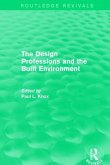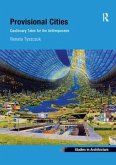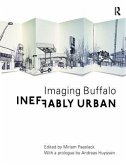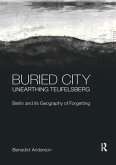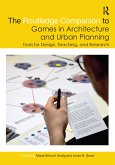Routledge Handbook of Chinese Architecture
Social Production of Buildings and Spaces in History
Herausgeber: Wei, Chen; Hua, Li; Zhu, Jianfei
Routledge Handbook of Chinese Architecture
Social Production of Buildings and Spaces in History
Herausgeber: Wei, Chen; Hua, Li; Zhu, Jianfei
- Broschiertes Buch
- Merkliste
- Auf die Merkliste
- Bewerten Bewerten
- Teilen
- Produkt teilen
- Produkterinnerung
- Produkterinnerung
This handbook, representing the collaboration of 41 scholars, provides a multi-faceted exploration of roughly 6,000 years of Chinese architecture, from ancient times to the present.
Andere Kunden interessierten sich auch für
![Routledge Handbook of Sustainable Design Routledge Handbook of Sustainable Design]() Routledge Handbook of Sustainable Design69,99 €
Routledge Handbook of Sustainable Design69,99 €![Routledge Revivals Routledge Revivals]() Routledge Revivals40,99 €
Routledge Revivals40,99 €![Provisional Cities Provisional Cities]() Renata TyszczukProvisional Cities71,99 €
Renata TyszczukProvisional Cities71,99 €![The Good, the Bad and the Ugly (Routledge Revivals) The Good, the Bad and the Ugly (Routledge Revivals)]() Rod HackneyThe Good, the Bad and the Ugly (Routledge Revivals)43,99 €
Rod HackneyThe Good, the Bad and the Ugly (Routledge Revivals)43,99 €![Ineffably Urban: Imaging Buffalo Ineffably Urban: Imaging Buffalo]() Miriam PaeslackIneffably Urban: Imaging Buffalo76,99 €
Miriam PaeslackIneffably Urban: Imaging Buffalo76,99 €![Buried City, Unearthing Teufelsberg Buried City, Unearthing Teufelsberg]() Benedict AndersonBuried City, Unearthing Teufelsberg70,99 €
Benedict AndersonBuried City, Unearthing Teufelsberg70,99 €![The Routledge Companion to Games in Architecture and Urban Planning The Routledge Companion to Games in Architecture and Urban Planning]() The Routledge Companion to Games in Architecture and Urban Planning90,99 €
The Routledge Companion to Games in Architecture and Urban Planning90,99 €-
-
-
This handbook, representing the collaboration of 41 scholars, provides a multi-faceted exploration of roughly 6,000 years of Chinese architecture, from ancient times to the present.
Hinweis: Dieser Artikel kann nur an eine deutsche Lieferadresse ausgeliefert werden.
Hinweis: Dieser Artikel kann nur an eine deutsche Lieferadresse ausgeliefert werden.
Produktdetails
- Produktdetails
- Verlag: Taylor & Francis Ltd
- Seitenzahl: 752
- Erscheinungstermin: 13. März 2025
- Englisch
- Abmessung: 246mm x 174mm
- Gewicht: 453g
- ISBN-13: 9781032363363
- ISBN-10: 1032363363
- Artikelnr.: 73143075
- Herstellerkennzeichnung
- Libri GmbH
- Europaallee 1
- 36244 Bad Hersfeld
- gpsr@libri.de
- Verlag: Taylor & Francis Ltd
- Seitenzahl: 752
- Erscheinungstermin: 13. März 2025
- Englisch
- Abmessung: 246mm x 174mm
- Gewicht: 453g
- ISBN-13: 9781032363363
- ISBN-10: 1032363363
- Artikelnr.: 73143075
- Herstellerkennzeichnung
- Libri GmbH
- Europaallee 1
- 36244 Bad Hersfeld
- gpsr@libri.de
Jianfei Zhu is Professor of East Asian Architecture at Newcastle University UK, author of Chinese Spatial Strategies (2004) and Architecture of Modern China (2009) with Routledge, as well as Forms and Politics (2018) and works on space, power, visuality, and geopolitics with a Chinese focus. Chen Wei is Professor, Director, History and Theory Research Institute, Southeast University China, eminent historian and architect on literati gardens and author of Private Gardens (1999), Collected Works of Chen Wei (2015), Ornament of Jiangnan (2016), Walking Along the Grand Canal (2 vols, 2013) in Chinese. Li Hua, PhD (AA), Professor, Deputy Director, History and Theory Research Institute, Southeast University, is author of '"Composition" and Regularisation of Architectural Production in Contemporary China' (2010) and other papers in China's top journal Jianzhu Xuebao, and editor-in-chief of bilingual AS series on architectural theory.
Introduction 1. Reassembling for a Chinese Architecture: Notes for a New
Departure PART I: ANCIENT AND DYNASTIC TRADITION State Governance Over
Building and City Planning 2. The Chinese City in the Service of the State
3. Typical Design Features of Ming Palaces and Altars in Beijing 4.
Imperial Cities: Critical Changes in Urban Paradigm from Sui-Tang to Song
5. Yingzao Fashi: The Book and Methodical Issues for Studying It Literati
Culture and Social Production 6. Literati Gardens of the Jiangnan Region:
Characters and Mutations 7. Cang Lang Pavilion of Suzhou: Sentiment,
Scenery, Aura, and Meaning 8. Landscape Urbanism: Urban-Rural Relations in
Hangzhou of Southern Song China 9. Confucian Authority: Analysis of
School-Temples at Imperial Academy of Beijing Folk Culture and Vernacular
Practice 10. Fengshui Practice and Urban Development in Ancient China: An
Outline 11. Yang Yunsong and the Jiangxi School of Fengshui Practice in
Southern China 12. Carpentry In Vernacular Building Practice: The Master's
Way 13. Vernacular Architecture: Themes and Variations Over a Large
Country. PART II: REPUBLICAN AND EARLY MODERN TRANSFORMATION The Arrival of
"Architecture": Profession, Knowledge, and Education 14. Emergence of
"Architecture": In the Reform Years of Late Qing Dynasty 15. The Architect
as a Profession in Republican China: Rising Under the State Modern Building
Practice: Style and Technology 16. Building Technology in Republican China
and Its Historical Legacies 17. Chinese Classical Revival: Nanjing, Capital
of Republican China (1910s-40s) Modern City Construction and Spatial
Formation 18. From Hankou Town to Greater Wuhan: Urban Spatial
Organizations in Early Modern China 19. Modern Edutainment Space: Public
Parks in Early Twentieth-Century China PART III: SOCIALIST-MAOIST
MODERNIZATION Spatial Construction and City Planning Under Socialist
Ideology 20. Socialist Urban Planning in Mao's China (1949-1976) 21 Danwei
and Socialist Urbanism Practice, Education, and Knowledge Production 22.
The Design Institute in Mao's China (1950s-70s) 23. Architectural Education
in China (1950s-1980s): Constructing and Deconstructing 24. Theories of
Spatial Composition: Design Knowledge in China up to the 1980s 25. Liang
and Liu: Strategies for Writing an Architectural History in the 1950s
Architecture in Socialist China: Nationalism and Modernism 26. National
Style: Thinking and Building for a New Republic in Beijing (1949-1959) 27.
Towards a Regional Modernism in Chinese Architecture (1930s-70s) 28. For a
Modernism: Huang and Feng at Shanghai's Tongji Architectural Programme 29.
Building Canton Fair: Towards a Regional Modernism in Southern China
(1950s-1980s) PART IV: CONTEMPORARY HISTORIES: CHINA IN THE WORLD
Architects and the Issue of Autonomy 30. Critical Pragmatism: Architects as
Refl exive Individuals in Contemporary China 31. Architects as Authoring
Individuals: Y. H. Chang, Liu Jiakun, and Wang Shu State Design Institutes
in the Reform Era 32. From Mao to Market: Evolution of the State Design
Institutes in China 33. The Chinese Design Institute: A Critique of
"Critical Thinking" CBDs: Global Spectacles 34. Objects in Territories
Along Avenues: Spatial Planning in Beijing and Shanghai 35. Iconic
Architecture in China (2000s): Historical Reading or Marxist Critique 36.
Urban-Rural Development in China and a Way Forward With "New Urbanization"
Geopolitical Differentiations 37. "Chinese Cultural Renaissance" and a
Chinese Neoclassicism: Taiwan (1960s-80s) 38. Architects as Reflexive
Individuals: Taiwan and Hong Kong Since the 1950s PART V: THEORIZATION
Culture and Epistemology 39. Ten Lamps of Architecture in Chinese Culture
40. Deriving Architectural Theory From Chinese Philosophy: ThinkingWith
Xunzi 41. Figuration: Writing, Memory, and Cities in Chinese Culture 42.
Signs of Empire: Scale and Statehood in Chinese Culture Political Ethics
43. The State Function of Architecture 44. Political Space and Moral
Statehood Methodology 45. Studies on Architecture of Ancient China: As in
Part I 46. Perspectives on Architecture of (Modern) China: As in Parts II-V
and Part I Appendix Timeline: Chinese History
Departure PART I: ANCIENT AND DYNASTIC TRADITION State Governance Over
Building and City Planning 2. The Chinese City in the Service of the State
3. Typical Design Features of Ming Palaces and Altars in Beijing 4.
Imperial Cities: Critical Changes in Urban Paradigm from Sui-Tang to Song
5. Yingzao Fashi: The Book and Methodical Issues for Studying It Literati
Culture and Social Production 6. Literati Gardens of the Jiangnan Region:
Characters and Mutations 7. Cang Lang Pavilion of Suzhou: Sentiment,
Scenery, Aura, and Meaning 8. Landscape Urbanism: Urban-Rural Relations in
Hangzhou of Southern Song China 9. Confucian Authority: Analysis of
School-Temples at Imperial Academy of Beijing Folk Culture and Vernacular
Practice 10. Fengshui Practice and Urban Development in Ancient China: An
Outline 11. Yang Yunsong and the Jiangxi School of Fengshui Practice in
Southern China 12. Carpentry In Vernacular Building Practice: The Master's
Way 13. Vernacular Architecture: Themes and Variations Over a Large
Country. PART II: REPUBLICAN AND EARLY MODERN TRANSFORMATION The Arrival of
"Architecture": Profession, Knowledge, and Education 14. Emergence of
"Architecture": In the Reform Years of Late Qing Dynasty 15. The Architect
as a Profession in Republican China: Rising Under the State Modern Building
Practice: Style and Technology 16. Building Technology in Republican China
and Its Historical Legacies 17. Chinese Classical Revival: Nanjing, Capital
of Republican China (1910s-40s) Modern City Construction and Spatial
Formation 18. From Hankou Town to Greater Wuhan: Urban Spatial
Organizations in Early Modern China 19. Modern Edutainment Space: Public
Parks in Early Twentieth-Century China PART III: SOCIALIST-MAOIST
MODERNIZATION Spatial Construction and City Planning Under Socialist
Ideology 20. Socialist Urban Planning in Mao's China (1949-1976) 21 Danwei
and Socialist Urbanism Practice, Education, and Knowledge Production 22.
The Design Institute in Mao's China (1950s-70s) 23. Architectural Education
in China (1950s-1980s): Constructing and Deconstructing 24. Theories of
Spatial Composition: Design Knowledge in China up to the 1980s 25. Liang
and Liu: Strategies for Writing an Architectural History in the 1950s
Architecture in Socialist China: Nationalism and Modernism 26. National
Style: Thinking and Building for a New Republic in Beijing (1949-1959) 27.
Towards a Regional Modernism in Chinese Architecture (1930s-70s) 28. For a
Modernism: Huang and Feng at Shanghai's Tongji Architectural Programme 29.
Building Canton Fair: Towards a Regional Modernism in Southern China
(1950s-1980s) PART IV: CONTEMPORARY HISTORIES: CHINA IN THE WORLD
Architects and the Issue of Autonomy 30. Critical Pragmatism: Architects as
Refl exive Individuals in Contemporary China 31. Architects as Authoring
Individuals: Y. H. Chang, Liu Jiakun, and Wang Shu State Design Institutes
in the Reform Era 32. From Mao to Market: Evolution of the State Design
Institutes in China 33. The Chinese Design Institute: A Critique of
"Critical Thinking" CBDs: Global Spectacles 34. Objects in Territories
Along Avenues: Spatial Planning in Beijing and Shanghai 35. Iconic
Architecture in China (2000s): Historical Reading or Marxist Critique 36.
Urban-Rural Development in China and a Way Forward With "New Urbanization"
Geopolitical Differentiations 37. "Chinese Cultural Renaissance" and a
Chinese Neoclassicism: Taiwan (1960s-80s) 38. Architects as Reflexive
Individuals: Taiwan and Hong Kong Since the 1950s PART V: THEORIZATION
Culture and Epistemology 39. Ten Lamps of Architecture in Chinese Culture
40. Deriving Architectural Theory From Chinese Philosophy: ThinkingWith
Xunzi 41. Figuration: Writing, Memory, and Cities in Chinese Culture 42.
Signs of Empire: Scale and Statehood in Chinese Culture Political Ethics
43. The State Function of Architecture 44. Political Space and Moral
Statehood Methodology 45. Studies on Architecture of Ancient China: As in
Part I 46. Perspectives on Architecture of (Modern) China: As in Parts II-V
and Part I Appendix Timeline: Chinese History
Introduction 1. Reassembling for a Chinese Architecture: Notes for a New
Departure PART I: ANCIENT AND DYNASTIC TRADITION State Governance Over
Building and City Planning 2. The Chinese City in the Service of the State
3. Typical Design Features of Ming Palaces and Altars in Beijing 4.
Imperial Cities: Critical Changes in Urban Paradigm from Sui-Tang to Song
5. Yingzao Fashi: The Book and Methodical Issues for Studying It Literati
Culture and Social Production 6. Literati Gardens of the Jiangnan Region:
Characters and Mutations 7. Cang Lang Pavilion of Suzhou: Sentiment,
Scenery, Aura, and Meaning 8. Landscape Urbanism: Urban-Rural Relations in
Hangzhou of Southern Song China 9. Confucian Authority: Analysis of
School-Temples at Imperial Academy of Beijing Folk Culture and Vernacular
Practice 10. Fengshui Practice and Urban Development in Ancient China: An
Outline 11. Yang Yunsong and the Jiangxi School of Fengshui Practice in
Southern China 12. Carpentry In Vernacular Building Practice: The Master's
Way 13. Vernacular Architecture: Themes and Variations Over a Large
Country. PART II: REPUBLICAN AND EARLY MODERN TRANSFORMATION The Arrival of
"Architecture": Profession, Knowledge, and Education 14. Emergence of
"Architecture": In the Reform Years of Late Qing Dynasty 15. The Architect
as a Profession in Republican China: Rising Under the State Modern Building
Practice: Style and Technology 16. Building Technology in Republican China
and Its Historical Legacies 17. Chinese Classical Revival: Nanjing, Capital
of Republican China (1910s-40s) Modern City Construction and Spatial
Formation 18. From Hankou Town to Greater Wuhan: Urban Spatial
Organizations in Early Modern China 19. Modern Edutainment Space: Public
Parks in Early Twentieth-Century China PART III: SOCIALIST-MAOIST
MODERNIZATION Spatial Construction and City Planning Under Socialist
Ideology 20. Socialist Urban Planning in Mao's China (1949-1976) 21 Danwei
and Socialist Urbanism Practice, Education, and Knowledge Production 22.
The Design Institute in Mao's China (1950s-70s) 23. Architectural Education
in China (1950s-1980s): Constructing and Deconstructing 24. Theories of
Spatial Composition: Design Knowledge in China up to the 1980s 25. Liang
and Liu: Strategies for Writing an Architectural History in the 1950s
Architecture in Socialist China: Nationalism and Modernism 26. National
Style: Thinking and Building for a New Republic in Beijing (1949-1959) 27.
Towards a Regional Modernism in Chinese Architecture (1930s-70s) 28. For a
Modernism: Huang and Feng at Shanghai's Tongji Architectural Programme 29.
Building Canton Fair: Towards a Regional Modernism in Southern China
(1950s-1980s) PART IV: CONTEMPORARY HISTORIES: CHINA IN THE WORLD
Architects and the Issue of Autonomy 30. Critical Pragmatism: Architects as
Refl exive Individuals in Contemporary China 31. Architects as Authoring
Individuals: Y. H. Chang, Liu Jiakun, and Wang Shu State Design Institutes
in the Reform Era 32. From Mao to Market: Evolution of the State Design
Institutes in China 33. The Chinese Design Institute: A Critique of
"Critical Thinking" CBDs: Global Spectacles 34. Objects in Territories
Along Avenues: Spatial Planning in Beijing and Shanghai 35. Iconic
Architecture in China (2000s): Historical Reading or Marxist Critique 36.
Urban-Rural Development in China and a Way Forward With "New Urbanization"
Geopolitical Differentiations 37. "Chinese Cultural Renaissance" and a
Chinese Neoclassicism: Taiwan (1960s-80s) 38. Architects as Reflexive
Individuals: Taiwan and Hong Kong Since the 1950s PART V: THEORIZATION
Culture and Epistemology 39. Ten Lamps of Architecture in Chinese Culture
40. Deriving Architectural Theory From Chinese Philosophy: ThinkingWith
Xunzi 41. Figuration: Writing, Memory, and Cities in Chinese Culture 42.
Signs of Empire: Scale and Statehood in Chinese Culture Political Ethics
43. The State Function of Architecture 44. Political Space and Moral
Statehood Methodology 45. Studies on Architecture of Ancient China: As in
Part I 46. Perspectives on Architecture of (Modern) China: As in Parts II-V
and Part I Appendix Timeline: Chinese History
Departure PART I: ANCIENT AND DYNASTIC TRADITION State Governance Over
Building and City Planning 2. The Chinese City in the Service of the State
3. Typical Design Features of Ming Palaces and Altars in Beijing 4.
Imperial Cities: Critical Changes in Urban Paradigm from Sui-Tang to Song
5. Yingzao Fashi: The Book and Methodical Issues for Studying It Literati
Culture and Social Production 6. Literati Gardens of the Jiangnan Region:
Characters and Mutations 7. Cang Lang Pavilion of Suzhou: Sentiment,
Scenery, Aura, and Meaning 8. Landscape Urbanism: Urban-Rural Relations in
Hangzhou of Southern Song China 9. Confucian Authority: Analysis of
School-Temples at Imperial Academy of Beijing Folk Culture and Vernacular
Practice 10. Fengshui Practice and Urban Development in Ancient China: An
Outline 11. Yang Yunsong and the Jiangxi School of Fengshui Practice in
Southern China 12. Carpentry In Vernacular Building Practice: The Master's
Way 13. Vernacular Architecture: Themes and Variations Over a Large
Country. PART II: REPUBLICAN AND EARLY MODERN TRANSFORMATION The Arrival of
"Architecture": Profession, Knowledge, and Education 14. Emergence of
"Architecture": In the Reform Years of Late Qing Dynasty 15. The Architect
as a Profession in Republican China: Rising Under the State Modern Building
Practice: Style and Technology 16. Building Technology in Republican China
and Its Historical Legacies 17. Chinese Classical Revival: Nanjing, Capital
of Republican China (1910s-40s) Modern City Construction and Spatial
Formation 18. From Hankou Town to Greater Wuhan: Urban Spatial
Organizations in Early Modern China 19. Modern Edutainment Space: Public
Parks in Early Twentieth-Century China PART III: SOCIALIST-MAOIST
MODERNIZATION Spatial Construction and City Planning Under Socialist
Ideology 20. Socialist Urban Planning in Mao's China (1949-1976) 21 Danwei
and Socialist Urbanism Practice, Education, and Knowledge Production 22.
The Design Institute in Mao's China (1950s-70s) 23. Architectural Education
in China (1950s-1980s): Constructing and Deconstructing 24. Theories of
Spatial Composition: Design Knowledge in China up to the 1980s 25. Liang
and Liu: Strategies for Writing an Architectural History in the 1950s
Architecture in Socialist China: Nationalism and Modernism 26. National
Style: Thinking and Building for a New Republic in Beijing (1949-1959) 27.
Towards a Regional Modernism in Chinese Architecture (1930s-70s) 28. For a
Modernism: Huang and Feng at Shanghai's Tongji Architectural Programme 29.
Building Canton Fair: Towards a Regional Modernism in Southern China
(1950s-1980s) PART IV: CONTEMPORARY HISTORIES: CHINA IN THE WORLD
Architects and the Issue of Autonomy 30. Critical Pragmatism: Architects as
Refl exive Individuals in Contemporary China 31. Architects as Authoring
Individuals: Y. H. Chang, Liu Jiakun, and Wang Shu State Design Institutes
in the Reform Era 32. From Mao to Market: Evolution of the State Design
Institutes in China 33. The Chinese Design Institute: A Critique of
"Critical Thinking" CBDs: Global Spectacles 34. Objects in Territories
Along Avenues: Spatial Planning in Beijing and Shanghai 35. Iconic
Architecture in China (2000s): Historical Reading or Marxist Critique 36.
Urban-Rural Development in China and a Way Forward With "New Urbanization"
Geopolitical Differentiations 37. "Chinese Cultural Renaissance" and a
Chinese Neoclassicism: Taiwan (1960s-80s) 38. Architects as Reflexive
Individuals: Taiwan and Hong Kong Since the 1950s PART V: THEORIZATION
Culture and Epistemology 39. Ten Lamps of Architecture in Chinese Culture
40. Deriving Architectural Theory From Chinese Philosophy: ThinkingWith
Xunzi 41. Figuration: Writing, Memory, and Cities in Chinese Culture 42.
Signs of Empire: Scale and Statehood in Chinese Culture Political Ethics
43. The State Function of Architecture 44. Political Space and Moral
Statehood Methodology 45. Studies on Architecture of Ancient China: As in
Part I 46. Perspectives on Architecture of (Modern) China: As in Parts II-V
and Part I Appendix Timeline: Chinese History


